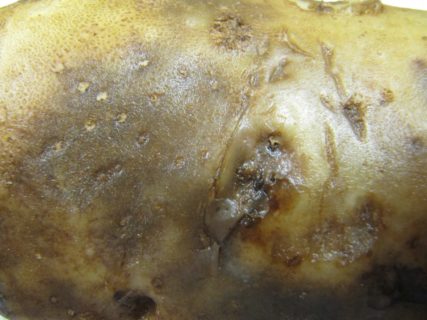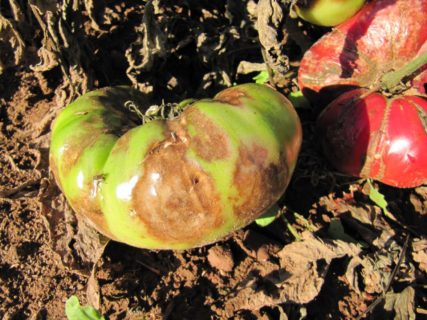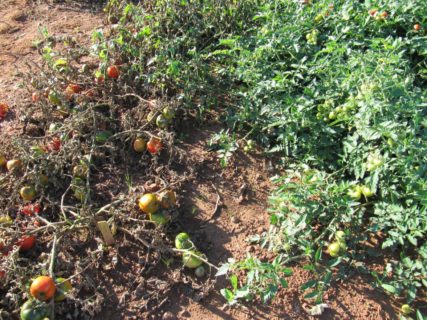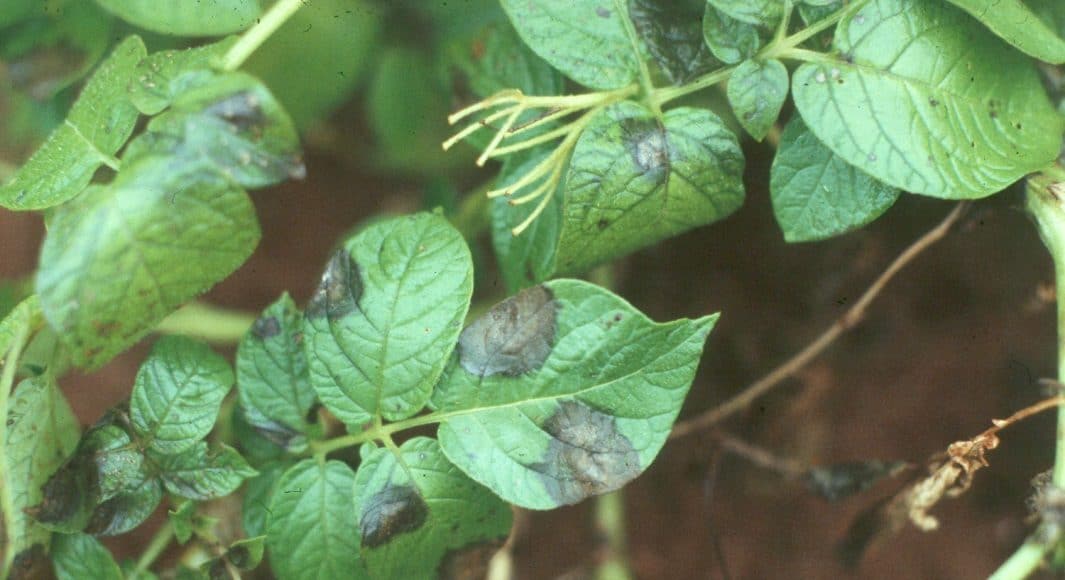[deck]Research on Canadian strains is revealing essential information for preventing and managing this disease. A new national effort is continuing this work.[/deck]
Strain monitoring in Canada over the past three decades shows successive waves of new strains have replaced older strains of the late blight pathogen. The latest findings from research to track and characterize the strains across the country are a combination of good and bad news with direct relevance for managing the current strains.
Rick Peters, a research scientist with Agriculture and Agri-Food Canada (AAFC) in Charlottetown, P.E.I., is co-leading this research with Larry Kawchuk, an AAFC research scientist in Lethbridge, Alta.
Peters explains the late blight pathogen, Phytophthora infestans, is a fungus-like organism. Its main hosts are potatoes and tomatoes, but other plants in the Solanaceous family, such as peppers, petunias and nightshade weeds, can also be infected.
Late blight strains can spread in different ways.
“The spores can be wind-blown from field to field. Infected seed tubers that move from one region to another can move strains around. And infected tomato transplants can also spread the strains,” he says.
The pathogen can reproduce sexually and asexually. With asexual reproduction, each generation is genetically identical to the previous generation, although random mutations can create new strains. Asexual reproduction contributes to the rapid spread of the disease during the growing season.
For sexual reproduction to occur, the pathogen’s two mating types, A1 and A2, have to come together. For instance, if an area has both the US-23 strain, which is an A1 type, and the US-8 strain, an A2 type, then sexual reproduction can occur. Sexual recombination increases the possibility of producing new strains and it produces oospores, which can survive in the soil without a living host.
Recent Strain, Host and Fungicide Findings
This past spring, Peters and Kawchuk completed a three-year project initiated in 2015 under AAFC’s AgriInnovation Program in partnership with the Canadian Horticultural Council and the potato industry. The project team, including collaborators across Canada, collected samples of infected potato and tomato tissues. They isolated the pathogen from each sample and determined its strain and mating type. They also evaluated each strain’s host preferences and aggressiveness on foliage and tubers, its fungicide sensitivity, and its response to different growing conditions.

Photo: Rick Peters/AAFC
Peters summarizes the strain trends in Canada in recent decades: “In the early 1990s, we had the US-1 strain, an A1 mating type that was quite sensitive to Ridomil. Then in the mid 1990s, we started to see some new strains, especially US-8, which is an A2 mating type and really resistant to Ridomil. US-8 quickly displaced US-1 and became fairly predominant in the country,” he says.
“We also saw US-11 in British Columbia in the mid-90s. US-11 is an A1 strain but also really resistant to Ridomil. Over the ensuing years, US-11 tended to be common on the West Coast, all the way from California to British Columbia. That was our first displacement event, where US-1 was displaced by some newer strains. Then we had another displacement event around 2009 and 2010 in Canada.”
In the second event, US-8 was displaced by newer strains such as US-22, US-23 and US-24, says Peters. Since 2011, US-23 has been the main strain, with the exception of British Columbia, where sometimes US-8 or US-11 can be found, and US-24 is present from time to time in Quebec.
The project team tested the strains on many tomato and potato varieties as well as on some pepper and petunia plants.
“US-8 was more adapted to potato than tomato; it was aggressive on both potato tubers and foliage. US-23 was really aggressive on tomatoes and really adapted to tomato foliage. It was less aggressive on potato foliage, but quite aggressive on potato tubers, a bit of a unique characteristic of that strain. US-24 was more adapted to potatoes and was aggressive on both potato foliage and tubers,” says Peters. Almost no late blight infection was found on pepper and petunia.
US-23 and US-24 were at least as aggressive as US-8 on potato tubers. All commonly grown potato varieties were susceptible to the tuber rot caused by US-23, US-24 and US-8.

Photo: Rick Peters/AAFC
Most commonly grown tomato varieties were very susceptible to US-23. However, a few varieties with at least two known resistance genes were very resistant to this strain.
“The second displacement event was really driven by tomato transplants. US-23 was on transplants coming from various parts of North America and moving into potato production areas. With US-8, we didn’t think much about the tomato angle because it was rare to see the disease in tomatoes with that strain. But with US-23, that has completely flipped. Tomatoes have become a major player in the epidemiology of the disease,” says Peters.
As a result, public outreach efforts are focusing on home gardeners, nurseries and garden centres. “We are working to convince home gardeners to grow late blight-resistant tomato varieties when possible. And if they are not growing resistant varieties, then we want them to really watch for the disease and destroy infected plants very quickly,” he says.
“For many parts of the country, this outreach has been pretty successful, and you’ll now find a lot more late blight-resistant material for purchase. But we are not out of the woods. We need to continue that outreach to keep the message strong in all parts of the country.”
The project’s fungicide sensitivity testing confirmed that US-23 and US-24 are sensitive to Ridomil, unlike US-8 and US-11. But Peters adds, “With US-23, sometimes we see a little bit of insensitivity creeping in as the season progresses.” He recommends that if growers decide to use Ridomil, then they should use only one application early in the season.
New Strains, Wider Temperature Range
The researchers have recently completed controlled environment studies to evaluate how the different strains respond to a range of temperatures. Most of this work focused on US-8, US-23 and US-24, the most common strains in the past four or five years. US-8, as the previously predominant strain, provided a baseline for comparison.
Some interesting results have come out of this work.

Photo: Rick Peters/AAFC
“One thing we found was the newer strains are able to produce spores earlier than US-8. If you think about a spore landing on a leaf, then germinating and infecting that tissue, then spreading within the tissue and eventually producing more spores, that whole process usually takes between four and seven days, depending on the weather and so forth. We have found that the newer strains can go through that process up to 24 hours faster than US-8. That gives them a competitive advantage,” says Peters.
In addition, the researchers found the new strains are able to go through the process of infecting and eventually producing new spores over a wider range of temperatures. According to Peters, US-8 does well anywhere between 10 and 20 C, which is the classic prime temperature range for late blight infection. “But we found that US-23 and US-24 could go from infection through to sporulation in both cooler and warmer temperatures,” he says.
“The new strains were still performing fairly well up to about 23 or 24 C and down to about 7, 8 or 9 C. That may give them a competitive advantage in climate change conditions where the weather can be a little more extreme, with warmer, drier conditions at times and cooler conditions at other times.”
The new strains have a higher potential to cause disease under a wider range of temperatures. This two-pronged competitive advantage may be why US-23 has displaced US-8 across most of Canada.
The researchers are sharing their temperature findings with provincial and private late blight forecasting services, so those services can incorporate the data into their forecasting models where appropriate.
Big News
Fortunately, 2018 was relatively quiet on the late blight front in Canada.
“That was largely because most production areas had a fairly warm, dry summer, which is typically not conducive to late blight, regardless of the strain,” Peters says.
“We only saw some late blight toward the mid to later part of the season in Ontario in both potatoes and tomatoes, and a little in British Columbia near the end of the season. The strain in Ontario was US-23 and we are in the process of identifying the B.C. strain.”
The big news from 2018 is the Canadian Horticultural Council and AAFC are funding a new project on late blight strains.
“We have a team together, with players across the country, to continue the late blight work for the next five years. We will continue tracking the strains across the country as well as determining the characteristics of the strains, like looking at fungicide sensitivity and the effects of different environmental conditions.”
Ongoing strain tracking is vital in case a third displacement event happens, bringing different strains that require different management strategies.
Testing for fungicide sensitivity will be a bigger part of the new project.
“The fungicides currently available for managing late blight are largely still very effective. However, we are starting to lose some of our more broad-spectrum products. As products like Bravo and Mancozeb start to perhaps be less available, growers will rely on more of the targeted products. Those targeted products are more susceptible to resistance development over time. We will really need to keep track of the resistance spectrum in the pathogen,” says Peters.
He stresses one of the key messages from the research so far is the new strains are still susceptible and manageable with the current tools. In addition to fungicide use, the classic measures for late blight management strategy are still valid for the new strains, such as “making sure cull piles aren’t spreading spores, destroying volunteer potato plants that have sprouted up in another crop, and using clean or treated seed — some seed treatments are available to help with late blight seed transmission,” says Peters.
He also emphasizes the need for constant vigilance with late blight management no matter the strain.
“US-23 can be sneaky because it is not very aggressive on potato foliage. Sometimes you will see it on the foliage, but you seem to be managing it fairly well with your fungicide programs or other management techniques. Then, suddenly, at harvest time, there is blight in the tubers, which obviously can be very serious because they will rot in storage,” he says.
“I have also seen situations where virtually no disease was noted in the foliage, but then a storm carried the spores into the field and the spores washed down and affected the tubers. Make sure you’re still thinking about late blight and managing it as best you can right up to the very end of the season.”











